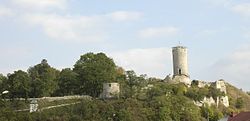Iłża
| Iłża | ||
|---|---|---|
 
Iłża castle and view of the town
|
||
|
||
| Coordinates: 51°10′N 21°15′E / 51.167°N 21.250°E | ||
| Country |
|
|
| Voivodeship | Masovian | |
| County | Radom | |
| Gmina | Iłża | |
| Town rights | 1239 | |
| Government | ||
| • Mayor | Andrzej Moskwa | |
| Area | ||
| • Total | 15.83 km2 (6.11 sq mi) | |
| Population (2006) | ||
| • Total | 5,165 | |
| • Density | 330/km2 (850/sq mi) | |
| Time zone | CET (UTC+1) | |
| • Summer (DST) | CEST (UTC+2) | |
| Postal code | 27-100 | |
| Area code(s) | +48 48 | |
| Car plates | WRA | |
| Website | http://www.ilza.pl/ | |
Iłża [ˈiu̯ʐa] is a small town in Masovian Voivodeship, Poland. It is located at around 51°10′0″N 21°15′0″E / 51.16667°N 21.25000°E. In 2004 Iłża had 5,178 inhabitants. The town belongs to Lesser Poland, and from its foundation until 1795, it was part of Lesser Poland’s Sandomierz Voivodeship. Iłża lies in Malopolska Upland, on the Iłżanka river, 30 kilometres (19 miles) south of Radom. The town is located along National Road Nr. 9, which is part of European route E371. It also is northern terminus of the Starachowice Narrow Gauge Line (Starachowicka Kolej Wąskotorowa), a 20-kilometre (12 miles) line built in the early 1950s, which now is open for tourists in the summer.
The history of the town dates back to the Middle Ages, when it was a Western Slavic gord. Since the 12th century, until 1789, Iłża belonged to the Bishops of Kraków. The settlement was twice destroyed by the Mongols (1241, 1260, see Mongol invasion of Poland), and probably in 1294 (or before that date) it received Magdeburg rights town charter. In 1340, a stone castle was built here by Bishop Jan Grot, which was expanded in the 15th and 16th centuries. At that time, Iłża emerged as the center of properties of Bishops of Kraków in northern Lesser Poland. In the 16th century, Iłża became famous for its potters and other artisans. The town prospered, together with whole Polish-Lithuanian Commonwealth. It was conveniently located on a merchant route from the heartland of Poland to the Vistula ports at Solec nad Wisłą, Zawichost, and Sandomierz. In 1576, a town hall was built at the main market square, Iłża had a defensive wall, and several Polish kings visited the castle. The decline of Iłża was brought by the Deluge (1655–1660), when Swedish and Transilvanian armies completely destroyed the town and the castle.
...
Wikipedia


